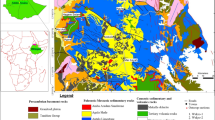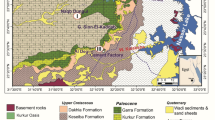Abstract
The Ordovician carbonate shoals are extensively developed in the Tarim Basin, NW China, and are taken as important petroleum reservoirs. The sedimentary characteristics and controlling factors of these shoals are poorly studied. Multiple means, including field geological investigations, core observations, thin section identifications by scanning electron microscope and cathodoluminescence microscope, granulometric analyses, and geochemical analyses, are conducted. The classification of limestones and shoals in the Ordovician of the Tarim Basin is established. Four types of shoals are developed, namely, intraclastic shoals, bioclastic shoals, oolitic shoals, and algal shoals. It is demonstrated that these four shoal types are deposited in progradation sequences, among which, the low energy bioclastic shoals are in the sequence of retrogradation. Different sedimentary environments develop various sedimentary combination patterns: the platform margin facies mainly develop reef–shoal combinations followed by shoal–shoal combinations; the open platform facies mainly develop shoal–shoal combinations and then reef–shoal combinations; the restricted platform facies develops restricted shoal combinations. Intraclastic shoals are the most developed shoals, which are directly controlled by hydrodynamic force that caused by sea level changes and paleogeography that dominated by tectonic movement. In the platform margin facies, shoals are well-developed with large thickness and limited horizontal extent, and the main shoal type is bioclastic shoal, followed by algae shoal. In the open platform facies, Shoals usually present thin-layered with large horizontal extent. The main shoal type is intraclastic shoal that shows a gently moundy or sill-like structure, the followings are bioclastic shoals and oolitic shoals that developed in the highland near the platform margin facies. In the restricted platform facies, a small number of shoals are developed, which distributed in striped shape paralleling to the shoreline. This study provides great guidance for predicting shoals in different sedimentary facies and build good foundation for future shoal-related reservoirs assessment and prediction.


















Similar content being viewed by others
References
Aigner T, Schauer M, Junghans WD et al (1995) Outcrop gamma-ray logging and its applications: examples from the German Triassic[J]. Sed Geol 100(1–4):47–61
Aigner T, Braun S, Palermo D et al (2007) 3D geological modelling of a carbonate shoal complex: reservoir analogue study using outcrop data[J]. First Break 25:65–72
Allwood AC, Walter MR, Burch IW et al (2007) 3.43 billion-year-old stromatolite reef from the Pilbara Craton of Western Australia: ecosystem-scale insights to early life on Earth[J]. Precambrian Res 158(3–4):198–227
Allwood AC, Kamber BS, Walter MR et al (2010) Trace elements record depositional history of an Early Archean stromatolitic carbonate platform[J]. Chem Geol 270(1–4):148–163
Amour F, Mutti M, Christ N et al (2013) Outcrop analog for an oolitic carbonate ramp reservoir: a scale-dependent geologic modeling approach based on stratigraphic hierarchy[J]. Aapg Bull 97(5):845–871
Bastian SK, Christian H, Frank P (2010) Multiple-scale facies and reservoir quality variations within a dolomite body—Outcrop analog study from the Middle Triassic, SW German Basin [J]. Mar Pet Geol 27(9):386–411
Bau M, Dulski P (1996) Distribution of yttrium and rare-earth elements in the Penge and Kuruman iron-formations, Transvaal Supergroup, South Africa[J]. Precambr Res 79(1–2):37–55
Belyaev SY, Basharin AK (2001) Modern structure, evolution, and petroleum potential of the zone of junction of the Siberian Platform and West Siberian Plate[J]. Geol Geofiz 42(4):736–745
Brandano M, Frezza V, Tomassetti L et al (2009) Facies analysis and palaeoenvironmental interpretation of the Late Oligocene Attard Member (Lower Coralline Limestone Formation), Malta[J]. Sedimentology 56(4):1138–1158
Braun S (2003) Quantitative analysis of carbonate sandbodies: outcrop analog study from an epicontinental basin (Triassic, Germany)[J]. University of Tübingen, 93
Casteleyn L, Robion P, David C et al (2011) An integrated study of the petrophysical properties of carbonate rocks from the “Oolithe Blanche” formation in the Paris Basin[J]. Tectonophysics 503(1–2):18–33
Ding WL, Qi LX, Yun L et al (2012a) The tectonic evolution and its controlling effects on the development of Ordovician reservoir in Bachu–Markit Tarim Basin[J]. Acta Petrologica Sinica 28(8):2542–2556 (In Chinese with English abstract)
Ding X, Chen JS, Tan XC et al (2012b) Structural characteristics of intra-platform shoal in the Leikoupo Formation (T2) in the transitional zone of the central and southern Sichuan Basin[J]. Pet Explorat Dev 39(4):444–451 (In Chinese with English abstract)
Dunham RJ (1962) Classification of carbonate rocks according to depositional texture. Classification of carbonate rocks[J]. Am Assoc Pet Geol Mem 1:108–121
Eltom HA, Abdullatif OM, Makkawi MH et al (2017) Rare earth element geochemistry of shallow carbonate outcropping strata in Saudi Arabia: application for depositional environments prediction[J]. Sed Geol 348:51–68
Fan TL, Gao ZQ, Liu C et al (2008) The characteristics of Palaeozoic slopes with different genesesand oil/gasplays in the Tarim Basin[J]. Earth Sci Front 15(2):127–136 (In Chinese with English abstract)
Flügel E (2013) Microfacies of carbonate rocks: analysis, interpretation and application[M]. Springer, Berlin
Folk RL (1959) Practical petrographic classification of limestone[J]. AAPG Bull 43(1):1–38
Frimmel HE (2009) Trace element distribution in Neoproterozoic carbonates as palaeoenvironmental indicator[J]. Chem Geol 258(3):338–353
Gao ZQ, Fan TL, Wang HM et al (2005) The developmental conditions and distributional rules of the reef-shoal reservoirs in central Tarim Basin[J]. Xinjiang Geol 23(3):283–287 (In Chinese with English abstract)
Gao ZQ, Ding Q, Hu X (2015) Characteristics and controlling factors of carbonate intra-platform shoals in the Tarim Basin, NW China[J]. J Pet Sci Eng 127:20–34
Grammer GM, Harris PM, Eberli GP (2001) Carbonate platforms: exploration and production scale insight from modern analogs in the Bahamas[J]. Lead Edge 20(3):252–261
Gu JY, Zhang XY, Luo P et al (2005) Development characteristics of organic reef-bank complex on Ordovician carbonate platform margin in Tarim Basin[J]. Oil Gas Geol 26(3):277–283 (In Chinese with English abstract)
Hu XL, Fan TL, Gao ZQ et al (2014) The depositional combination characteristics and distribution of ordovician carbonate shoals in the Tarim Basin[J]. Acta Sedimentol Sin 32(3):418–428 (In Chinese with English abstract)
Jia CZ, Wei GQ (2002) Structural characteristics and petroliferous features of Tarim Basin[J] (English edition). Sci Bull 047(0Z1):1–11
Jiao W, Lv X, Zhou Y et al (2011) Main controlling factors of the Ordovician carbonate reservoirs in Tazhong area, the Tarim Basin[J]. Oil Gas Geol 32(2):199–206 (In Chinese with English abstract)
Kang YZ (2007) Reservoir rock characteristics of Paleozoic marine facies carbonate rock in the Tarim Basin. Pet Geol Express 29(3):217–222
Kennedy SK, Mazzullo J (1991) Principles, methods, and application of particle size analysis: image analysis method of grain size measurement[J]. Cambrige University Press. pp 76–87
Liu LF, Wang P, Li Y et al (2009a) Paleozoic reservoir beds and their favorableness in Tazhong Areas of Tarim Basin, Northwest China[J]. J Petrol Sci Eng 68(1–2):1–18
Liu W, Zhang XY, Gu JY (2009b) Sedimentary environment of lower-middle ordovician yingshan formation in mid-western Tarim Basin [J]. Acta Sedimentol Sin 27(3):435–442 (In Chinese with English abstract)
Lønøy A (2006) Making sense of carbonate pore systems[J]. AAPG Bull 90(9):1381–1405
Luo P, Zhang J, Liu W et al (2008) Characteristics of marine carbonate hydrocarbon reservoirs in China[J]. Earth Sci Front 15(1):36–50 (In Chinese with English abstract)
Ma YS, Cai XY, Zhao PR et al (2010) Distribution and further exploration of the large-medium sized gas fields in Sichuan Basin[J]. Acta Petrolei Sinica 31(3):347–354 (In Chinese with English abstract)
McLennan SM (1989) Rare earth elements in sedimentary rocks: influence of provenance and sedimentary processes[J]. Geochemistry and Mineralogy of Rare Earth Elements. pp 169–200
Meng MM, Fan TL, Wei D et al (2018) Sedimentary characteristics and reef-forming models of the Ordovician reefs in Lianglitage area, Tarim Basin[J]. J Paleogeogr 20(2):175–190 (In Chinese with English abstract)
Meng MM, Liu XX, Fan TL et al (2019) Rare earth elements and yttrium (REY) geochemistry of reefal limestones in the ordovician, Tarim Basin, NW China and their paleoenvironment implications[J]. Acta Geologica Sinica (Eng Ed) 93(4):928–942
Nothdurft LD, Webb GE, Kamber BS (2004) Rare earth element geochemistry of Late Devonian reefal carbonates, Canning Basin, Western Australia: confirmation of a seawater REE proxy in ancient limestones[J]. Geochim Cosmochim Acta 68(2):263–283
Olivier N, Boyet M (2006) Rare earth and trace elements of microbialites in Upper Jurassic coral-and sponge-microbialite reefs[J]. Chem Geol 230(1–2):105–123
Rankey EC, Reeder SL (2011) Holocene oolitic marine sand complexes of the Bahamas[J]. J Sedim Res 81(1–2):97–117
Rankey EC, Riegl B, Steffen K (2006) Form, function and feedbacks in a tidally dominated ooid shoal, Bahamas[J]. Sedimentology 53(6):1191–1210
Ruf M, Aigner T (2004) Facies and poroperm characteristics of a carbonate shoal (Muschelkalk, South German Basin): a reservoir analogue investigation[J]. J Pet Geol 27(3):215–239
Shen AJ, Zheng JF, Gu QY (2008) Reservoir geological models of reef complexes in the Middle Ordovician Yijianfang Formation in the Bachu area, Tarim basin, and its implication for hydrocarbon exploration in the Tazhong area, Xinjiang, China[J]. Geol Bull Chin 27(1):137–148 (In Chinese with English abstract)
Shields GA, Webb GE (2004) Has the REE composition of seawater changed over geological time?[J]. Chem Geol 204(1–2):103–107
Sun LD, Fang CL, Li F et al (2010) Petroleum exploration and development practices of sedimentary basins in China and research progress of sedimentology[J]. Pet Explorat Dev 37(4):385–396 (In Chinese with English abstract)
Tan XC, Liu XG, Chen JS et al (2009) Shoal development within the epicontinental carbonate platform Jia2 member, Lower Triassic, Moxi Gas Field, Central Sichuan Basin[J]. Acta Sedimentol Sin 27(5):995–1001 (In Chinese with English abstract)
Tucker ME, Wright VP (2009) Chapter 9. The geological record of carbonate rocks[M]. Carbonate sedimentology. Blackwell Publishing Ltd
Wang ZM, Zhang LJ, Wang ZY et al (2007) Features of ordovician reef beach and exploration activities in Tarim Basin[J]. Pet Geol 6:1–7 (In Chinese with English abstract)
Wang CL, Wu GH, Cui WJ et al (2011) Characteristics and distribution of intra-platform beach of the lower-middle ordovician yingshan formation carbonate in Tarim Basin[J]. Acta Sedimentol Sin 29(6):1048–1057 (In Chinese with English abstract)
Webb GE, Kamber BS (2000) Rare earth elements in Holocene reefal microbialites: a new shallow seawater proxy[J]. Geochim Cosmochim Acta 64(9):1557–1565
Yu BS, Chen JQ, Lin CS (2005) Sequence stratigraphic framework and its control on development of Ordovician carbonate reservoir in Tarim basin[J]. Oil Gas Geol 26(3):305–309 (In Chinese with English abstract)
Zhang LJ, Li Y, Zhou CG et al (2007) Lithofacies paleogeographical characteristics and reef–shoal distribution during the orodovician in the Tarim Basin[J]. Oil Gas Geol 28(6):731–737 (In Chinese with English abstract)
Zhao ZJ, Pan WQ, Zhang LJ et al (2009) Sequence stratigraphy in the ordovician in the Tarim Basin[J]. Geotecton Metallog 33(1):175–188 (In Chinese with English abstract)
Zhao WZ, Shen AJ, Zhou JG et al (2014) Types, characteristics, origin and exploration significance of reef-shoal reservoirs: a case study of Tarim Basin, NW China and Sichuan Basin, SW China[J]. Pet Explorat Dev 41(3):257–267 (In Chinese with English abstract)
Zhu ZD, Hu MY, Liu BL (2006) Early-middle ordovician reefs in China[M]. Geological Publishing House, Beijing (In Chinese with English abstract)
Acknowledgements
This research is supported by the National 973 program of China (Grant Number 2012CB214802) and the China Geological Survery Project (Grant Number DD20190217). The Northwest Company of SINOPEC is acknowledged for material retrieval. Dr. Meng would also like to thank the China Scholarship Council (Grant Number 201606400023) for the financial support during the study at the University of Texas at Austin. Thanks are given to editor-in-Chief and anonymous reviewers for their critical and constructive reviews.
Author information
Authors and Affiliations
Corresponding author
Additional information
Publisher's Note
Springer Nature remains neutral with regard to jurisdictional claims in published maps and institutional affiliations.
Rights and permissions
About this article
Cite this article
Meng, M., Fan, T. Sedimentary characteristics and formation mechanisms of the Ordovician carbonate shoals in the Tarim Basin, NW China. Carbonates Evaporites 35, 74 (2020). https://doi.org/10.1007/s13146-020-00591-8
Accepted:
Published:
DOI: https://doi.org/10.1007/s13146-020-00591-8




